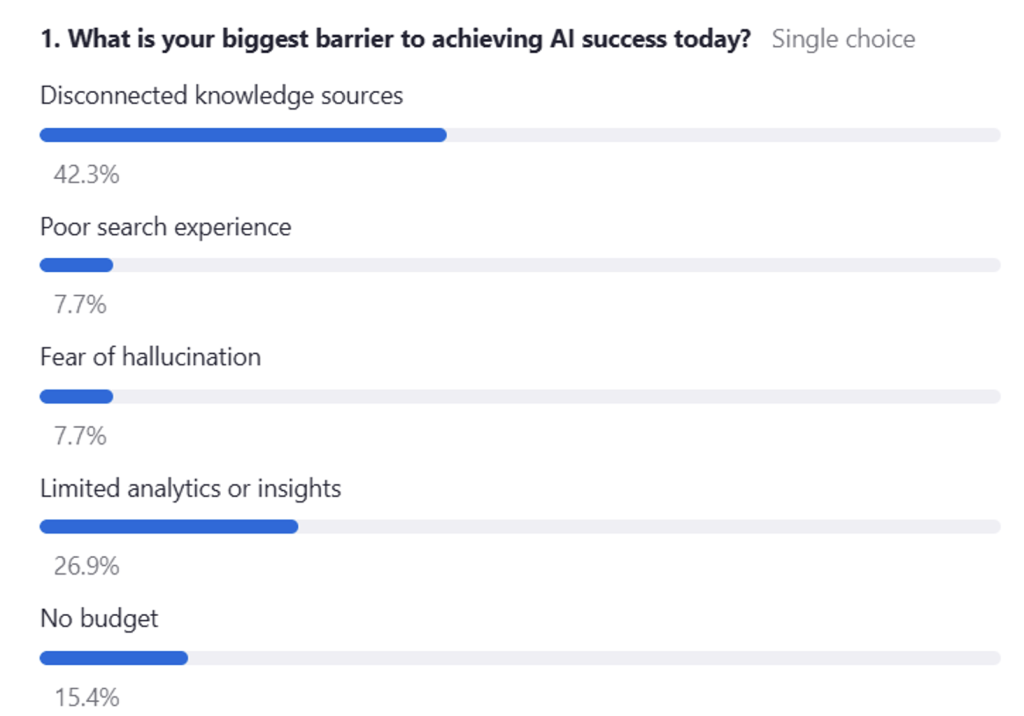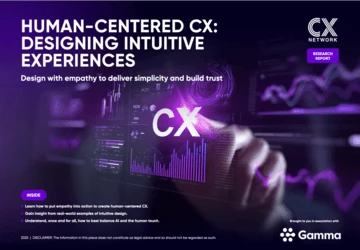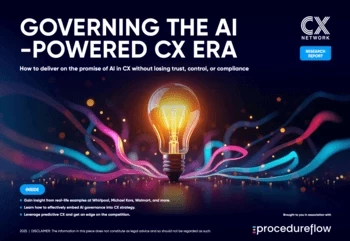Preparing your data for AI in CX: Ethics, centralization and adoption
Add bookmark
Similarly to the trends identified by CX Network’s Global State of CX in 2024 survey, artificial intelligence (AI) dominated the top 10 trends practitioners say are impacting their work in 2025. For AI to be effective, organizations need to have robust data governance with clean, centralized data.
CX Network’s second annual installment of All Access: AI + Data in CX was a success because fantastic speakers covered all bases, from internal governance, innovative culture and AI ethics to the nuts and bolts of generative search, agentic AI implementation and self-service chatbots.
If you missed the live sessions, you can catch them on-demand here, or read on for a summary of the key takeaways from each session.
Understanding intent and making full use of AI in product development
Jon Howard, executive product manager for AI and innovation at the BBC presented the pilot project he is spearheading that explores how generative AI can support learners and teaching.
He walked us through the development of a conversational agent designed to provide personalized tutoring, emphasizing the importance of ensuring accuracy and safety. “We realize that a conversational agent with generative AI has a massive risk index”, he said, and explained that intent detection is central to guardrail success "Understanding the intent is key[…] If you try to solve every problem with one big Uber set of prompts, everything falls over but breaking into smaller chunks based on user intent makes the system shine."
Howard also touched on wider uses of generative AI beyond being the foundation of the product itself: "We used a lot of GenAI, not just to build the system, but to classify data, process unformatted PDFs, create validation sets and analyze trends. There's no way we could've developed this with our small team without it."
Watch the full session on the BBC on-demand here.
Ethical AI and data protection
The second session was focused on ethical AI and navigating complex data protection regulations around the world. Joe Smyth, SVP of R&D, digital and AI and Margaret Baumgartner, deputy general counsel for intellectual property and product joined Arpita Maity-Peschard, director of product marketing for AI, all at Genesys, to discuss principles of ethical AI, and how to put these into practice.
The presenters spoke about the importance of transparency, explainability, fairness and privacy in AI development and highlighted the need for automated processes to ensure data security and compliance with regulations. Maity-Peschard kicked off the conversation by pointing out that “AI by itself does not have a moral compass... it needs to be trained, it needs to be given those guardrails so that it tries to mimic the positive qualities of a human — empathy and judgment."
Baumgartner acknowledged the challenge of balancing necessary innovation with legal considerations, saying, “I want to make sure that I'm always balancing innovation with the risk... because above all, we need to make money." She spotlighted the need for organizational education about safe and responsible AI use to ensure legal compliance and data security.
Smyth stressed the importance of building a responsible AI framework, saying “You have to build the tools into your development and production deployment processes to automate fairness, transparency, and explainability."
Smyth also discussed learning from previous mistakes to improve and nurturing a culture in which it is safe to do that, stating that “We have a no-blame culture, but a rigorous learning-from-mistakes culture."
Watch the full session on-demand here.
Repairing disconnected CX
At the beginning of the third session, CX Network polled the audience, asking “What is your biggest barrier to achieving AI success today?” and the results were telling, with "Disconnected knowledge sources" emerging as the most popular answer.

Source: CX Network, created in house 2025
Daniel Rajan, lead product marketing manager at Coveo, was unsurprised by this result, saying “Even the most impressive piece of AI technology... can fall flat if it's pulling from incomplete, outdated or siloed information.”.
Rajan talked on the current, mostly disjointed state of multi-channel self-service, pointing to customer frustration and even journey abandonment resulting from this.
The solution, he said, is an intelligent AI search layer to connect channels and knowledge sources and provide “relevance, intent and context across the entire journey.”.
Rajan advocated for a “crawl, walk, run” approach as follows:
- Crawl: Index existing knowledge where it lives: “You don’t have to migrate content... you simply need to connect it.”
- Walk: Use machine learning to improve relevance: “The system learns from behavior... what people search for... what they can’t find.”
- Run: Introduce Generative AI backed by trusted content: “Generative AI is only as good as the content behind it... that's where retrieval augmented generation (RAG) comes into play.”
The session concluded with an insight into Zoom’s AI journey. We learned that Zoom struggled with scattered and siloed knowledge, with users having a hard time finding answers. By partnering with Coveo, it could index without having to replatform, unlocking powerful business impact: “Using Coveo's usage analytics... gave them this X-ray vision... and supported newer use cases like training internal employees.”
Watch the full session on-demand here.
Unified data as a basis for AI
Heather Hughes, director of product marketing for AI Platform at NICE, echoed other speakers’ sentiment that clean, orderly data must be the basis for any AI initiative for it to succeed. “AI is only as good as the data that it uses.”, she explained, “If you don't have the right data... customers and agents are not having the most efficient, engaging or best experiences.” Access to both real-time and historical data through a unified data model removes friction, Hughes said.
Hughes referred to several case studies during her session, including Sony’s. The conglomerate automated and personalized customer service with impressive results, including a 7 times increase in self-service, a 15 times increase in voice and SMS containment and a 2-3 minute increase in agent efficiency overall. Carnival UK’s case study was also presented, with Hughes explaining that, by embedding NICE’s CXOne Empower application, the cruise line was about to use predictive modeling to boost efficiency, generate guest insights and drive significant business gains.
Watch the session on-demand here.
Centralizing customer insights, product marketing and customer service at Walmart
Montserrat Padierna joined All Access: AI + Data in CX to share how centralizing customer insights, data, product marketing, and customer service under one Customer Office has improved CX across Walmart Mexico’s diverse retail formats.
A large part of the strategy was consolidating data into a centralized hub, using internal and external data to create a 360-degree customer view, with Padierna explaining “There’s a lot of good data points out there. Traditionally, you’d analyze it by silo, but when you put everything together… interesting patterns emerge.” A continuous feedback loop ensures data becomes insight becomes strategy, and strategy leads to measurable results for customers and the business: “We built a continuous feedback loop... we measure, learn, optimize and repeat weekly.” On fighting analysis paralysis, Padierna said they use agile sprints to prioritize the key pain points that detract from customer experience.
Watch the full session on-demand here.
Preparing for agentic AI in CX
Agentic AI is the new kid on the CX tech block with a lot of excitement in the CX community about its potential to transform backend and support operations, saving time and money while preserving great CX.
Mike Myer, founder and CEO of Quiq, began the next session by defining agentic AI: “An AI agent that is able to plan, understand, make decisions within a set of scope and some guardrails, and take an action on those decisions,” explaining that the different between agentic and generative AI is “agentic is much more like what a frontline customer service agent would do in the contact center, and prior generations are more like a knowledge-based search."
Ejieme Eromosele, VP of customer growth, also at Quiq, shared a furniture retailer use case for end-to-end CX support, explaining that the retailer used agentic AI for “everything from hiring and answering product questions, recommending items, to tracking orders and handling account related inquiries.” The benefits they saw were numerous, including reduced time to resolution, reduced costs and increased customer satisfaction.
Eromosele also covered a lead generation case study in the beauty industry, explaining that the beauty and aesthetics company used the AI agent to collect lead information, generating a 5 times ROI in just the first few months following implementation.
Finally, Myer and Eromosele teamed up to explain the five most common pitfalls to be aware of when implementing agentic AI and how to mitigate them:
- Internal fear and resistance
- Eromosele: “Educate your teams on how AI can actually support and not replace their roles... involve them in testing before deployment.”
- Unrealistic expectations
- Myer: “Don’t let perfect be the enemy of good... AI doesn’t have to be 100% perfect to provide value greater than human agents.”
- Stakeholder misalignment
- Eromosele: “Align stakeholders early... identify impacted teams and assign clear roles.”
- Thinking you must have perfect data first
- Myer: “You can just actually use AI and some prompts to clean up the data... Don’t let data quality be a barrier.”
- Lock-in with inflexible vendors
- Eromosele: “Work with platforms that are flexible and can scale with you.”
Watch the full session on-demand here.
Self-service at Spirit Airlines
Our final session of day one was a fireside chat with Vanessa Hardy-Bowen, director of guest care and contact centers at Spirit Airlines, who explained how the carrier scaled self-service with AI.
We started off with the inflection point: the COVID-19 pandemic. The pandemic exposed the limits of manual customer service during peak times, highlighting the need for scalable, AI-driven solutions. Frequent call surges due to disruptions required proactive solutions so that guests could get answers right away during stressful travel situations.
Hardy-Bowen and her team started with ‘low-hanging fruit’, automating simple tasks such as refunds, baggage issues and flight credits, “high volume repetitive transactions that didn't require a lot of human empathy...they just needed speed, clarity, accuracy.”. Success was defined by containment rates and guest satisfaction scores.
When asked about building in-house versus partnering with vendors, Hardy-Bowen said the key is collaboration between internal teams and vendors: “Internally, we always have a vision...but we don’t always have the speed or the tech capability...that’s where our vendors bring that support.”
When selecting a vendor, Hardy-Bowen recommended being clear on expectations and not being afraid to pivot if a partner can’t grow with business needs: “sometimes a graceful exit is better than spending 6 months in a mismatch.”
Ultimately, her closing advice to CX leaders starting out with AI was “start small. Pick something meaningful...engage your internal partners early...and connect the AI strategy with guest experience and cost goals.”
Watch the session on-demand here.
AI beyond efficiency for enhanced CX
Day two opened with a panel discussion featuring digital transformation and AI expert, Srinivas Sandiri, and managing principle and fractional CXO at jCX Strategies, Jessica Carroll.
The discussion focused on leveraging AI to enhance CX, with both speakers highlighting the important of focusing on customer needs rather than internal efficiencies, with Sandiri saying “AI is real. ROI lies in creating a personalized, connected, and emotional, intelligent experience — not just saving costs, but building trust and long-term loyalty.”
Carroll echoed this sentiment, emphasizing that leaders must shift from building tech from the inside out to building with customers’ real needs in mind: “We tend to think about the tool before we're thinking about the purpose and the problem that we're solving for.”. She continued “if the customer is telling us they have a desire to do whatever it may be that would make their experience better, we need to look at that seriously.”
Sandiri then pointed out that the ideal model is hybrid, with both humans and AI in the fold. AI is best for high-volume, routine tasks as “that’s where the customer expects speed and self-service, and automation truly shines.” Meanwhile humans remain essentials for emotionally sensitive situations because “trust is built not through speed, but through listening and care.”
Watch the full discussion on-demand here.
CAI’s approach to AI adoption in the contact center
CAI is a global services firm providing business, workforce and technology services to public and commercial clients. CAI’s contact center handles about 90,000 contacts per month across multiple channels and languages.
In this session, Tom Grosso, executive director of service desk at CAI, joined Bob Schulenberg, customer success manager at Talkdesk, to discuss how AI has transformed the service desk for 500,000 end-users.
Beginning with Talkdesk’s Copilot AI tool to assist agents, Grosso said “Our goal was to not replace service desk agents with AI… our intent is to get efficiency gains and to make our agents’ lives easier.” They have since expanded into AI for knowledge management and quality assurance, also.
When asked about adoption, Grosso acknowledge that it can be a challenge: “Adoption just does not happen overnight... a service desk agent could be a creature of habit... It’s change.” Executive support and clear vision for success, he added, are critical to rollout success.
Watch the full session on-demand here.
AI adoption and good data management
Eric Doherty, president and CEO of DPE International and seasoned healthcare executive, joined the event to discuss the challenges and opportunities in AI adoption.
He emphasized the need for organizations to understand their desired outcomes before attempting to implement one of the three pillars of AI: machine learning, generative AI and agentic AI.
Doherty highlighted the importance of clean data, noting that disparate systems that don’t talk to each other are a major operational challenge: “The data going into a system...has to be very, very well defined...succinct...accurate and clean.”
He also referenced the importance of continuously training non-technical stakeholders, saying, “The data and IT side in the AI world can be very foreign to [non-technical stakeholders]...they will need to be trained on it—and continually trained.”
Watch the full session on-demand here.
Empathy and emotional intelligence in AI for CX
Ashlea Atigolo, AI expert and co-founder of INATIGO, said, when it comes to AI, “Smart isn't enough... Emotional connection is what people want. They want to understand. They want to be understood.”
While acknowledging that generative AI provides speed, Atigolo noted that “people are starting to put in generative AI... because they want that quick speed... But it doesn't necessarily mean that is what the customer wants," emphasizing that “empathy should be at the heart of AI."
To do this, businesses should design AI in CX to respond to various emotions along the customer journey, such as confusion, distress and frustration. She recommended partnering with experts in conversational AI who understand both technical and emotional nuances.
She also advised that generative AI is not a plug-and-play add-on, but requires a fresh architectural approach: “Generative AI is a completely new subset of conversational AI, and it needs to be designed separately and differently.” On agentic AI, she noted that successful AI agents need frameworks, feedback loops, sentiment detection, escalation paths and transparency.
Finally, when measuring the success of AI in CX, she referenced that important metrics include CSAT, reduction in human escalations, accuracy and emotional response tracking.
Watch the full session on-demand here.
AI for CX optimization
Jeofrey Bean, CX expert, author, consultant and teacher, rounded off the event discussing three main roles for AI in CX: automating analysis and reporting, serving as a CX input and facilitating direct customer interactions.
For this, he referenced the importance of “CX intelligence” (CXI), defined as a "cultural and systematic combination of inside and outside inputs from customers and users" about "all the interactions they have with your business online and offline." Multiple inputs are crucial as each input will have blind spots. The purpose of CXI is to drive customers to make referrals and advocate for a brand.
He also highlighted the importance of “thick data,” comprised of "in-person interviewing and ethnography, which is skilled ethical observation of people while they're having that interaction." Combining thick data with other, more quantitative data, is essential in a CXI approach.
The stages of CXI development are, according to Bean, as follows:
- Companies lacking CXI or manually analyzing insights and recommendations from inputs.
- A “partially automated” and “well-tested” process, possibly using AI for data sorting and simple interpretation of words.
- "Mostly automated with some human interactions to get the insights and recommendations to improve the strategy and the interactions," representing where "the most advanced companies are right now."
Watch the full session on-demand here.
Quick links:
- How Conduent prepares customers for automation
- Digital CX budgets on the rise in 2025
- 12 Takeaways on the AI revolution in CX





















